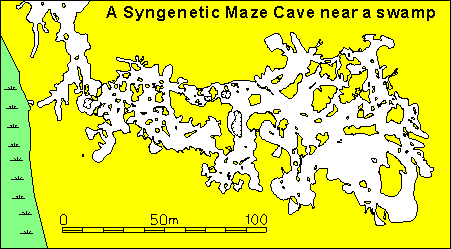
The dune limestones (or aeolianites) are a series of calcareous sand ridges which formed as dunes along the present or prior coastlines during the Quaternary (the last 2 million years, and pretty young by geological standards). The dune ridges are now partly consolidated calcarenites: that is, sandy limestones in which the sand grains are mainly fragments of marine shells that grew in the shallow seas, were washed up onto the beach, and then blown inland.
In these calcareous Quaternary dunes some karst features are "syngenetic", in that they have developed at the same time as the sand was being cemented into a rock. The term was coined by Joe Jennings in 1968, based partly on observations made by Lex Bastian in West Australia and Alan Hill in South Australia. The unconsolidated calcareous sand of the coastal dunefields is gradually converted to limestone by solution and redeposition of calcium carbonate by percolating water. This initially produces a caprock or calcrete layer which is capable of supporting the roof of a shallow cave. The downward percolating water also dissolves vertical solution pipes, and at the same time cements the surrounding sand. It then continues to carry dissolved calcium carbonate downward to slowly cement and strengthen the deeper sands. Simultaneously, enhanced mixing corrosion occurs where percolation water meets the water table - typically at the level of an adjacent swampy plain or at the sea. In the early stages the soft sand subsides immediately and no cavities remain, but once the rock is sufficiently hardened to support a roof, the solution at the water table results in the development of horizontal caves at that level.
Because the "rock" has limited strength, it collapses easily and breakdown is extensive, particularly in the early stages. As the rock becomes harder, and solution continues at the base of the cave (commonly beneath the rubble piles) larger chambers can form. In some West Australian cave areas, the water flow is concentrated along valleys in the surface of an impermeable basement and linear stream caves result.
 |

Solution pipes are one of the most distinctive features of syngenetic karst. They are vertical cylindrical tubes with case-hardened walls, typically 0.5 to 1 m in diameter, which can penetrate down from the surface as far as 20 metres into the soft limestone. The pipes may contain roots (and root growth may have occurred hand-in-hand with solution of the pipe). They occur as isolated features, or in clusters with spacings as close as a metre or so. Many of the caves are entered via such pipes.
 |
 |
| Solution Pipe entrance to a cave. Click on photo for a larger view (45kb.JPG) | Solution Pipes with indurated rims. Click for a larger view (93kb.JPG) |
Syngenetic karst development is typical of the Quaternary dune calcarenites; however, the Tertiary limestone at Mount Gambier, in South Australia, is also a relatively soft porous limestone, and consequently it shows some of the features of syngenetic karst, in particular the development of solution pipes and calcreted caprocks.
Copyright (c) Ken Grimes, 1998: ken-grimes@h140.aone.net.au
URL for this page: http://www.netserv.net.au/cwork/ackma99/grimes/Syngen.htm